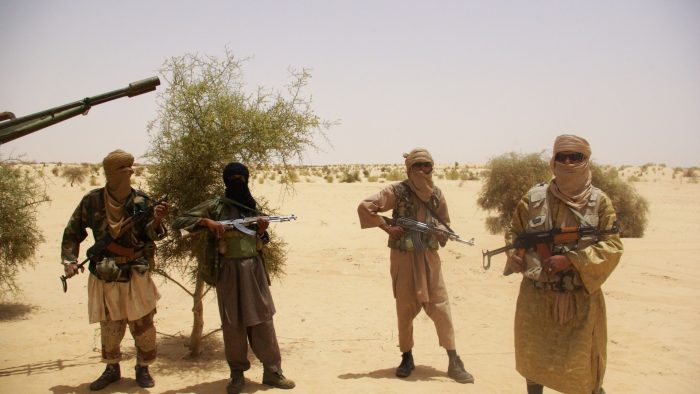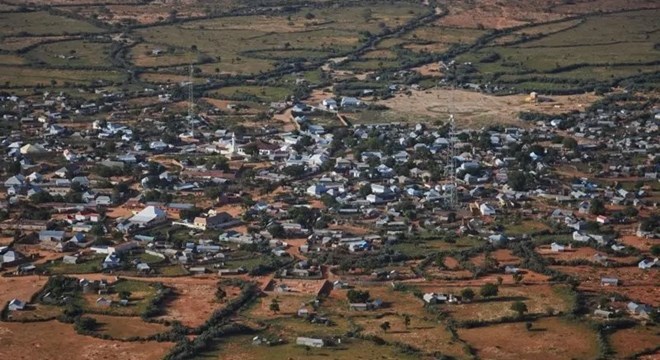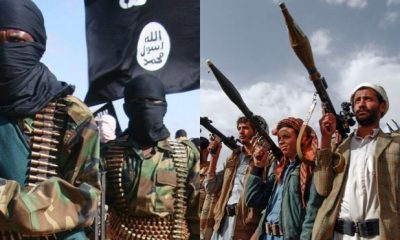Terrorism
Up to 200 Killed in Deadly Attack in Central Burkina Faso

Al-Qaeda-Linked Group Claims Responsibility for Devastating Assault
On Saturday, the central region of Barsalogho in Burkina Faso experienced a catastrophic attack claimed by Jama’at Nusrat al-Islam wal-Muslimin (JNIM), an armed group affiliated with al-Qaeda. The assault, which targeted individuals digging defensive trenches, has resulted in up to 200 fatalities and injured at least 140 others.
The attack occurred approximately 40 kilometers (25 miles) north of Kaya, a critical town noted for housing the last standing forces protecting Burkina Faso’s capital, Ouagadougou. The attackers targeted teams engaged in trench-digging efforts designed to bolster security. In addition to the heavy casualties, several soldiers are reported missing, and attackers seized weapons and a military ambulance.
Senegal, highlighted the grim reality faced by survivors. JNIM posted distressing footage of the aftermath, revealing victims—men, women, and children—laying in the trenches they had been digging, which have become mass graves. The local hospital has called in additional medical staff from Kaya to manage the influx of casualties.
Burkina Faso’s military had received warnings of a possible attack the previous day and had mobilized efforts to dig trenches, reflecting the urgency and desperation in their defense measures. The country has struggled with armed groups linked to al-Qaeda, with significant portions of territory falling under their control.
Following a severance of ties with Western allies, including France, Burkina Faso has sought assistance from Russian mercenaries to bolster its defense efforts. Despite this support, the violence has intensified, approaching the capital and posing severe challenges for the country’s military leaders.
The current government, which came to power through a coup in 2022, faces ongoing internal unrest and attempts at further coups, exacerbating the difficult situation in combating armed groups and ensuring national security.
Somalia
Al-Shabaab Reclaims Aadan Yabaal: Is Mogadishu Next?

The collapse of Middle Shabelle town exposes Somalia’s crumbling counteroffensive and re-energizes fears of a militant siege on the capital.
In a devastating blow to Somalia’s fragile counterinsurgency effort, Al-Shabaab militants stormed and seized the strategic town of Aadan Yabaal in Middle Shabelle—an area President Hassan Sheikh Mohamud himself toured just weeks earlier to inspire confidence. The government’s response? Silence. The militants’ message? We’re not done yet.
The Wednesday dawn assault, characterized by explosions, heavy artillery, and five hours of intense ground combat, ends with the fall of what was once a forward base for government operations. It’s a symbolic and strategic defeat: Aadan Yabaal had served as a key operations center against militant-controlled areas since its recapture in 2022.
Al-Shabaab’s Shabelle offensive is working. With over 50% more attacks in 2025 compared to last year, the militant group is flipping the script. After federal gains in 2022, the insurgents are now taking back ground—and fast. This isn’t just a tactical setback; it’s a psychological one.
Sources indicate the government’s forces conducted a “tactical withdrawal.” But it’s hard to spin the loss of a heavily militarized town as anything less than a collapse. Videos released by Al-Shabaab show fighters unchallenged inside the town, flaunting weapons and capturing vehicles. The symbolism is undeniable: The militants are organized, mobile, and emboldened.
Even more concerning is what this loss portends. The pattern suggests a strategic encirclement of Mogadishu. Villages within 50 kilometers of the capital have fallen. Assassination attempts on the president are growing. The Aadan Yabaal loss isn’t an isolated flare-up—it’s a warning shot.
Community militias and remnants of the federal army are reportedly preparing a counteroffensive. But the truth is, Al-Shabaab has just sent a chilling message: the war is far from over—and they’re winning battles that matter.
If Aadan Yabaal can fall so easily, how long before Mogadishu becomes more than just a target?
Analysis
America Pulls the Plug on Somalia: UN Funding Blocked, AUSSOM on the Brink

Trump eyes embassy closures as US rejects UN plan to fund peacekeepers in Somalia — Mogadishu’s last lifeline in peril.

The US shocks the UN by rejecting funding for African Union forces in Somalia, just as Trump weighs closing the US Embassy in Mogadishu. With Al-Shabaab advancing and oil politics heating up, is Somalia doomed to implode?
The United States just signaled the collapse of Somalia’s last fragile security architecture — and it did so with chilling clarity. Washington has publicly rejected UN efforts to fund the African Union Stabilization Support Mission in Somalia (AUSSOM), effectively gutting any hope for predictable peacekeeping operations in a country teetering on the edge of collapse.

This isn’t just a bureaucratic snub — it’s a geopolitical death sentence for Somalia. Al-Shabaab militants are already testing the vacuum, launching a multi-pronged assault on Adan Yabaal, a key military base in Middle Shabelle. If confirmed, the town’s fall would mark the largest strategic loss since Somalia launched its offensive against terror in 2022.
UN Secretary-General António Guterres warned the Security Council: no funding, no peace. But the US—under Trump’s second-term posture—is slamming the door shut, labeling Somalia as unfit for a hybrid funding model under Resolution 2719. Diplomats are in a panic. Meanwhile, Trump is reportedly planning to close up to 30 diplomatic missions, with Mogadishu’s embassy topping the list.
Somalia’s response? Desperation disguised as diplomacy. The FGS is now peddling oil blocks in contested territories like Nugaal Valley. In a flashy announcement on X, Somalia’s ambassador to the US declared “Somalia is open for drilling,” targeting American firms with an offer it legally and militarily cannot secure.

Somalia’s Ambassador to the United States, Dahir Hassan Arab
The move comes after Somalia’s recognition of SSC-Khaatumo — a region still engulfed in the political wreckage of its war with Somaliland.
This isn’t about development. It’s about weaponizing recognition, resource manipulation, and fake sovereignty in a bid to win Trump’s favor and undermine Somaliland’s momentum.
But while Hargeisa builds forests and attracts foreign media praise, Mogadishu is drowning in debt, insurgency, and denial. The West is tuning out, and even the UN is losing patience. The US, once Somalia’s diplomatic oxygen, is now pulling the plug.
Somalia is not rising — it’s being unplugged.
Terrorism
Africa’s Shadow War: ISIS Eyes West African Statehood as Sahel Collapses

With the Sahel in chaos, ISIS-backed factions push deeper into West Africa, aiming to create a new Islamic State across porous borders.
As counterinsurgency fails in Mali, Burkina Faso, and Niger, ISIS-linked terror groups are marching toward Ghana, Benin, and Togo—threatening to remake the region into a caliphate.
A dangerous transformation is unfolding across West and North Africa—one that mirrors the rise of ISIS in Iraq and Syria. This time, the black flag isn’t flying over Mosul or Raqqa—but is inching its way through Cameroon, Benin, Ghana, and Togo.
What was once a regional insurgency is morphing into a transnational movement. From deadly attacks on Cameroonian soldiers at the Nigerian border to dismantled ISIS cells in Morocco and Spain, signs of a looming continental jihad are flashing bright red.
Analysts from the Middle East Institute and Israel’s International Institute for Counter-Terrorism now warn that ISIS’s territorial campaign in the Sahel could escalate into a full-blown Islamic State in West Africa. The battlefield: vast forests, porous borders, and regions crippled by fragile governance. The model: weaponizing local grievances, exploiting economic despair, and smuggling across ungoverned spaces like Nigeria’s Sambisa and Burkina Faso’s W-Arly-Pendjari Complex.
The group’s rise is enabled by collapsing state structures. Mali, Burkina Faso, and Niger have all been rocked by coups and anti-Western sentiment, forcing France and the U.S. to reduce or reorient their military footprints. Into this vacuum, ISIS and its affiliates are pouring in—armed, funded, and inspired.
Charles Lister compares the scale of ISIS activity in the Sahel to the 2013–14 blitzkrieg in Iraq. “It’s an army marching at will,” he says. Their aim is not just terror. It’s governance—enforced through Sharia, brutality, and propaganda.
UN Deputy Secretary-General Amina Mohammed warns of a 250% surge in attacks in West Africa in just two years. Youth marginalization, skyrocketing unemployment, and rising extremism are creating a combustible mix. If this isn’t checked, ISIS may no longer just haunt the region—it could rule it.
Bottom line: This is no longer about Boko Haram or lone-wolf attacks. This is an insurgency with state-building ambitions — Watch West Africa become the next caliphate.
Somalia
Death of Imprisoned Somali Military Officer Sparks Questions

Sheegow Ahmed Ali’s death in custody ignites controversy amid denials of foul play.
The sudden death of Somali military officer Sheegow Ahmed Ali, who passed away Monday night at Mogadishu’s Digfeer Hospital after complications from Hepatitis B and liver failure, has reignited complex tensions and suspicions within Somalia’s political and military landscape. While authorities swiftly dismissed claims of foul play, asserting medical transparency, the incident nonetheless highlights deeper systemic vulnerabilities within Somali state institutions.
Sheegow, who was sentenced last year following violent clashes between his forces and government troops, held significant operational roles, including combating the al-Shabaab insurgency in Lower Shabelle. His incarceration alone had already polarized opinion, and his untimely death in custody only amplifies existing distrust towards federal authorities, especially among his Jareerweyne clan community.
Despite firm denials by Minister of Health Dr. Ali Haaji Aden and public acceptance from Sheegow’s family regarding the official medical findings, widespread rumors of potential poisoning illustrate the pervasive distrust between the state and certain clan communities. This undercurrent of suspicion is symptomatic of a broader crisis: a fragile relationship between the Somali government and various clan-based factions.
For the administration of President Hassan Sheikh Mohamud, handling this sensitive case transparently and effectively is imperative to maintaining stability. Any perception of foul play, regardless of official denials, risks undermining government credibility, particularly at a moment when Mogadishu seeks to bolster domestic legitimacy and strengthen security forces amid persistent al-Shabaab threats.
The Somali authorities must do more than merely deny wrongdoing. Comprehensive transparency, independent verification, and open channels of communication are crucial. The case of Sheegow Ahmed Ali isn’t just about one individual’s tragic demise; it’s a litmus test for the credibility of Somalia’s military justice system and governance institutions.
With the nation’s stability already precarious, this incident underscores the urgent need for reform in military custody practices, improved medical oversight for detainees, and greater governmental accountability. The Somali people will undoubtedly watch closely as this story unfolds, determining whether it represents a turning point toward justice and transparency—or another missed opportunity that deepens divisions.
Somalia
Mortar Mayhem in Mogadishu: Al-Shabaab Strikes Expose Somalia’s Vulnerabilities

Rising Al-Shabaab Attacks Challenge Mogadishu’s Security Apparatus, Exposing Critical Weaknesses.
Mortar shells rained down on Mogadishu for the second consecutive day, underscoring Al-Shabaab’s renewed aggression and the Somali government’s glaring security failures. Sunday morning’s attack, targeting the strategic Aden Adde International Airport and heavily fortified Halane compound, highlights a critical vulnerability in Somalia’s fight against terrorism.
Suspected Al-Shabaab militants unleashed six mortar rounds, two of which detonated in the densely populated Kaawa Godey neighborhood, injuring at least two civilians—a woman and a child. This attack followed closely on the heels of Saturday’s devastating shelling in the Warta Nabada and Boondheere districts, injuring six civilians, including personnel from the National Theater.
The brazen strikes, aimed at critical infrastructure like the international airport and the Halane compound—home to the United Nations, foreign embassies, and African Union peacekeepers—are not just symbolic. They are tactical attempts by Al-Shabaab to project power and sow chaos in the heart of Somalia’s capital. Despite years of international aid, training, and military support, the capital remains susceptible to Al-Shabaab’s persistent guerrilla tactics.
The repeated attacks expose deep-seated intelligence and security lapses. Mogadishu’s authorities remain reactive, caught off guard despite clear precedent. This demands a tough reassessment of the security framework. With Al-Shabaab regaining momentum, Mogadishu risks descending back into chronic instability unless the government responds with decisive, proactive measures.
Somalia stands at a crossroads. To truly neutralize the Al-Shabaab threat, Mogadishu must overhaul its security strategies, intensify intelligence operations, and reinforce its defenses. Failure to do so will only embolden militants further, putting countless Somali lives—and regional stability—at risk.
Analysis
Algeria’s Secret War Machine: How a Nation Fuels Africa’s Terrorism

Algeria’s secret backing of militias and extremist groups threatens regional stability as Western powers remain silent.
Uncover how Algeria covertly funds and arms terror groups across Africa, fueling insurgencies and reshaping geopolitical dynamics under diplomatic cover.
Algeria, long perceived as a diplomatic mediator in North Africa, is unmasked as a key enabler of Africa’s deadliest insurgencies. Mounting intelligence and intercepted arms shipments reveal a calculated Algerian strategy: arming extremist militias and separatists to destabilize rivals and position itself as a regional kingmaker.
At the epicenter of this clandestine operation lies Algeria’s unyielding support for the Polisario Front, the militant separatists fighting Morocco over Western Sahara. Algeria has provided the Polisario with Russian-made MANPADS and Iranian drones—dangerously sophisticated weaponry that threatens to ignite a broader conflict. This isn’t solidarity; it’s proxy warfare designed to keep Morocco embroiled in a perpetual crisis while Algeria watches from a comfortable distance.
But Algeria’s shadow influence reaches far beyond Western Sahara. In the Sahel, a region devastated by jihadist insurgencies, Algerian weapons routinely find their way into the hands of notorious extremist groups like Al-Qaeda in the Islamic Maghreb (AQIM) and ISIS affiliates. Despite public denials, intelligence sources reveal that Algeria deliberately allows weapons to filter into these insurgencies, thus amplifying chaos and asserting itself as an indispensable regional power broker.
At the heart of this covert war lies Algeria’s Department of Intelligence and Security (DRS)—a secretive military intelligence agency whose agenda prioritizes strategic autonomy through destabilization. Unlike Morocco, which engages diplomatically and economically, Algeria’s military-led leadership covertly fuels insurgencies to achieve geopolitical objectives, playing a double game that allows it to simultaneously condemn and enable terrorism.
Alarmingly, Algeria’s shadow war is bolstered by deep ties to Russia and Iran. As Africa’s largest importer of Russian arms, Algeria stockpiles weaponry that is subsequently funneled to non-state actors. The emergence of advanced Iranian drones in regional conflicts underscores Algeria’s calculated effort to spread instability and reshape power dynamics without direct accountability.
Yet, the international community has been dangerously silent. European powers reliant on Algerian gas, and the U.S., entangled in global geopolitical crises, remain reluctant to confront Algeria directly. However, voices in Washington calling for sanctions under CAATSA are growing louder, indicating cracks in Algeria’s diplomatic armor.
Ignoring Algeria’s secret war risks plunging Africa further into chaos. It’s time the West held Algeria accountable, exposed its double game, and acted decisively to halt its deadly influence before the region spirals irreversibly out of control.
Somalia
Ethiopia Joins AU Mission: Will This End Al-Shabaab’s Terror?

Ethiopia Deploys 2,500 Troops to Crush Al-Shabaab and Stabilize Somalia Under New AU Initiative.
Ethiopia deploys thousands of troops under the African Union’s new peacekeeping force in Somalia, intensifying efforts to eliminate Al-Shabaab and reshape regional power dynamics.
Ethiopia’s involvement marks a pivotal moment. Once facing resistance from Somalia over a deal with Somaliland, Ethiopia’s role was secured through diplomatic breakthroughs facilitated by Turkey. The new mission’s objective is unambiguous: to bolster Somali security forces and aggressively reclaim territory from Al-Shabaab militants, notorious for deadly attacks destabilizing East Africa.
Ethiopia joins forces from Uganda, Djibouti, Kenya, and Egypt—each contributing significant military personnel. Particularly notable is Egypt’s deployment of 1,100 troops, reflecting Cairo’s broader ambitions amid tense disputes with Ethiopia over the Grand Ethiopian Renaissance Dam. These strategic moves underscore how the fight against Al-Shabaab intersects with larger geopolitical rivalries.
Funding and sovereignty remain contentious issues, with Somalia demanding clear agreements like the new Status of Forces Agreement (SOFA) to safeguard national interests. Still, the mission faces financial uncertainty, relying heavily on international aid from the United States, EU, Turkey, and China.
The real test for Ethiopia and its partners will be effectiveness on the ground. Despite decades of international intervention, Al-Shabaab remains lethal, recently targeting Somali President Hassan Sheikh Mohamud’s convoy. The coalition’s success in dismantling Al-Shabaab’s strongholds will determine if this latest effort brings lasting peace or further regional turmoil.
Ultimately, Ethiopia’s bold troop deployment could turn the tide against terrorism—if regional politics and resource struggles don’t undermine the mission first.
Editor's Pick
Captive German Nurse Makes Desperate Plea After 7-Year Somalia Ordeal

Sonja Nientiet urges swift German government intervention, warning her health is critically deteriorating after seven years in captivity.
In a new video released after seven agonizing years of captivity in Somalia, German nurse Sonja Nientiet has urgently pleaded for the German government to intensify efforts to secure her immediate release. Nientiet, who was abducted in Mogadishu in 2018 while working for the International Committee of the Red Cross (ICRC), expressed dire concerns about her rapidly deteriorating health.
“My health is deteriorating,” Nientiet says emotionally in the video, posted by an individual named Liibaan Osman. She urgently warns that “every day that passes makes the situation more critical,” emphasizing that her prolonged captivity could soon claim her life.
Nientiet was kidnapped on May 2, 2018, after armed assailants—allegedly with inside help from a disgruntled security guard—stormed the ICRC office in Mogadishu. Despite intensive German intelligence efforts to track down her location and captors, who have demanded millions of dollars in ransom, the nurse remains captive and vulnerable.
The release of this disturbing footage has intensified pressure on the German government to secure Nientiet’s freedom. Yet, authorities have publicly maintained their longstanding policy of silence on hostage negotiations, declining direct comment.
Before her abduction, Nientiet had provided humanitarian assistance in Syria and the Democratic Republic of Congo, highlighting her commitment to aid in conflict zones. The ICRC expressed renewed urgency following the video, stating deep concern for her safety and health.
With her desperate plea now public, the stakes for Germany have dramatically increased, shifting the crisis into an urgent test of diplomatic resolve—one where each passing day could tragically mark the difference between life and death.
-

 Analysis1 month ago
Analysis1 month agoSaudi Arabia’s Billion-Dollar Bid for Eritrea’s Assab Port
-

 ASSESSMENTS2 weeks ago
ASSESSMENTS2 weeks agoOperation Geel Exposes the Truth: International Community’s Reluctance to Embrace Somaliland as a Strategic Ally
-

 Somaliland3 months ago
Somaliland3 months agoSomaliland and UAE Elevate Ties to Comprehensive Strategic Partnership
-

 Africa1 year ago
Africa1 year agoHow Somaliland Could Lead the Global Camel Milk Industry
-

 Analysis1 year ago
Analysis1 year agoIran escalates conflict, attacking Israel; US forces help Israel to intercept Iranian projectiles
-

 Top stories11 months ago
Top stories11 months agoGunmen Kill 11 in Southeastern Nigeria Attack, Army Reports
-

 Analysis1 year ago
Analysis1 year agoIsrael and Iran on Edge: Tensions Escalate Amidst Rising Threats
-

 TECH11 months ago
TECH11 months agoZimbabwe Approves Licensing of Musk’s Starlink Internet Service






























